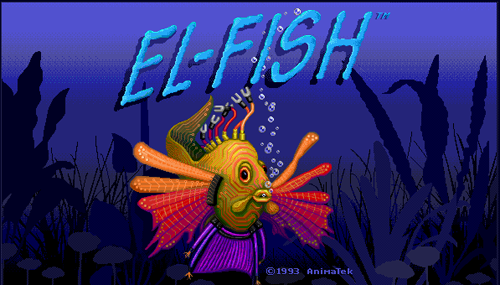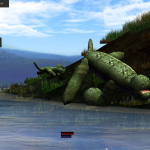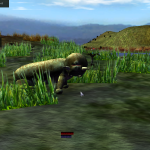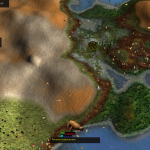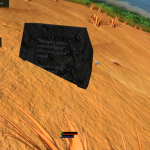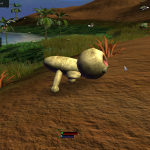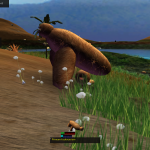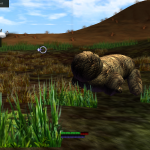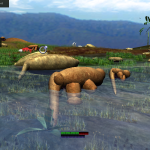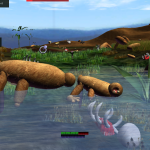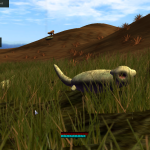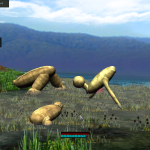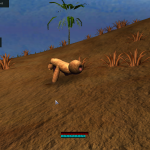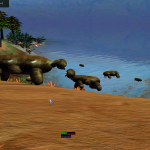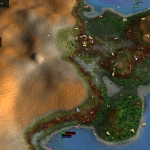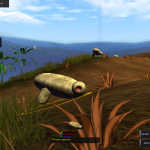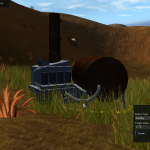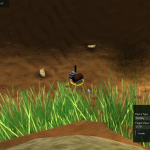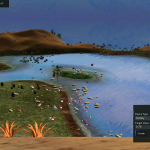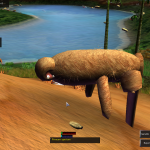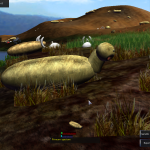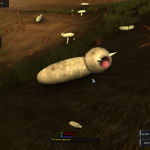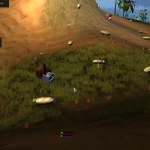Wow. Remember when I blogged about games besides Creatures? Me, too. Don’t worry, we’ll return to our regularly schedules Creatures stuff, but I wanted to take a break and check out something kinda different.
If you hadn’t guessed from my previous looks at Aquazone Deluxe 2 With Guppies, I love fish and I love keeping fish. I used to keep a fresh water aquarium back home in Okinawa but now I keep a tarantula in that tank. (Speaking of, if you know of any good tarantula-pet sims, you let me know, ok?) Anyway…
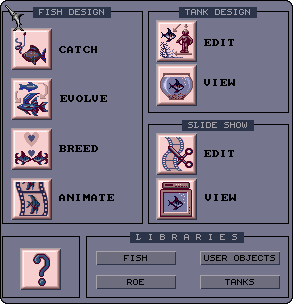 Today, I’m looking at El-Fish. I know very little about this game besides the fact that it’s about fish and, apparently, I can catch, evolve, breed and animate them, according to this menu. I can also edit and view tanks and there’s a slide show feature. The question mark (?) at the bottom opens the help menu.The libraries are where you manage your tanks, fish and other things. You can delete, rename and import new objects from the library, which is handy if you want to share fish and tanks with other users. Not a feature I’m likely to use, but it’s interesting all the same.
Today, I’m looking at El-Fish. I know very little about this game besides the fact that it’s about fish and, apparently, I can catch, evolve, breed and animate them, according to this menu. I can also edit and view tanks and there’s a slide show feature. The question mark (?) at the bottom opens the help menu.The libraries are where you manage your tanks, fish and other things. You can delete, rename and import new objects from the library, which is handy if you want to share fish and tanks with other users. Not a feature I’m likely to use, but it’s interesting all the same.
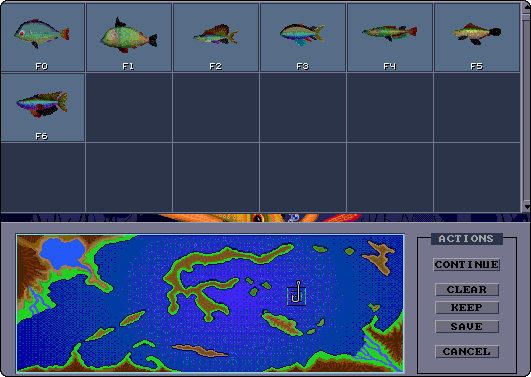 Not having any guidance, beside the manual that I hadn’t yet read, I decided to start by checking out the “Catch” menu. I selected a location with the hook and started automatically catching fish. I stopped when I’d caught 7 since that seemed to be a good place to start. Then, I was given a chance to look at each fish. Here’s what I caught.
Not having any guidance, beside the manual that I hadn’t yet read, I decided to start by checking out the “Catch” menu. I selected a location with the hook and started automatically catching fish. I stopped when I’d caught 7 since that seemed to be a good place to start. Then, I was given a chance to look at each fish. Here’s what I caught.
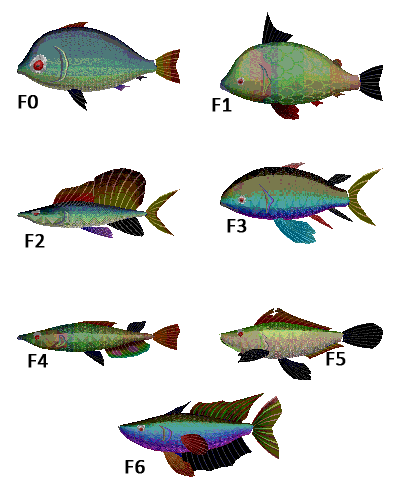 Of course, now that I had these fish, I must’ve had to do something with them (and eating them wasn’t an option). Checking out the “evolve” option next revealed that there were already fish in the game that I could play with. Either way, I wanted to evolve one of the fish I’d caught.
Of course, now that I had these fish, I must’ve had to do something with them (and eating them wasn’t an option). Checking out the “evolve” option next revealed that there were already fish in the game that I could play with. Either way, I wanted to evolve one of the fish I’d caught.
I chose F0 and pressed “Evolve”. Like catching the fish, evolving was an automatic process. I could move the variation sliders but otherwise, the process was very hands off. I selected a few of the fish that I’d liked and went back to check out the breed option.
 Because of their similarity to each other, I chose these two “evolved” versions of F0, F9 and F10. They were also somewhat similar to each other, and I wanted to see if I could get a strain of fish from them. I cleared my other fish from the records to make things simpler.
Because of their similarity to each other, I chose these two “evolved” versions of F0, F9 and F10. They were also somewhat similar to each other, and I wanted to see if I could get a strain of fish from them. I cleared my other fish from the records to make things simpler.
 I’d also turned down the shape variation and turned up the color variation just to see what would happen. Out of sheer luck, I got two offspring that looked identical to each other. When I bred them with the variation high, they still produced offspring that didn’t look terribly like them. I doubted this game had complex genetics, but it was still fun to play around with the sliders and see what offspring the game would produce.
I’d also turned down the shape variation and turned up the color variation just to see what would happen. Out of sheer luck, I got two offspring that looked identical to each other. When I bred them with the variation high, they still produced offspring that didn’t look terribly like them. I doubted this game had complex genetics, but it was still fun to play around with the sliders and see what offspring the game would produce.
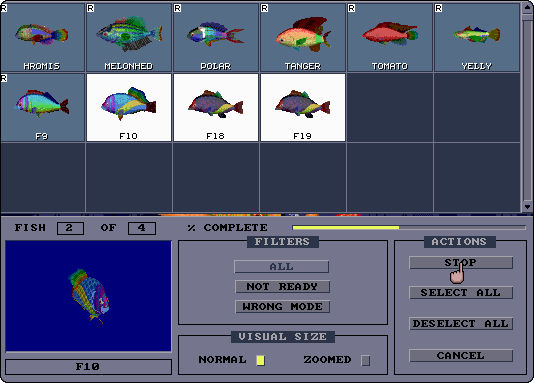 Finally, I took F9, F10, F18 and F19 into the Animation menu to see what that would do. I had to wait a while for the animation process to complete and I watched the frames compile. Not especially thrilling, but interesting for a few moments or so. Actually, watching my fish render isn’t unlike waiting for a video to render. Thankfully, I had my knitting to keep me occupied while I waited.
Finally, I took F9, F10, F18 and F19 into the Animation menu to see what that would do. I had to wait a while for the animation process to complete and I watched the frames compile. Not especially thrilling, but interesting for a few moments or so. Actually, watching my fish render isn’t unlike waiting for a video to render. Thankfully, I had my knitting to keep me occupied while I waited.
I’d also taken some time to read the manual and found that the game is really just about playing with the fish to make tanks and fish that appealed to you. It’s like a fish-based, fancy, less user-driven version of Spore. With less gameplay. At least it’s honest when it says it’s about making cool looking animals and little else (BA-ZING).
Naturally, and especially because I love fish tanks and decorating fish tanks, this meant that once rendering was done, I had to do something artsy with the tanks. I found that the plants were less stock than I thought and were also randomly generated based on the room you gave them to grow. It’s a neat idea and well implemented.
Many new fish and one stock tank later, this is what I created. See the music attribution below the video – the stock music isn’t great. Normally, I’d have used a .gif here, but the video (hilariously) produced a smaller file size.
“Carefree” Kevin MacLeod (incompetech.com)
Licensed under Creative Commons: By Attribution 3.0
http://creativecommons.org/licenses/by/3.0/
And that’s it! You make fish that you like, tanks that you like and then sit back and watch the fish. It’s a relaxing program, but the rendering wait is killer if you don’t have anything else to do in the meantime (which, honestly, I normally do). The game is abandonware, so you can find it pretty much anywhere abandonware can be found. It needs DosBox to run on most modern computers.
If you make any fish or tanks of your own, make sure to share them in the comments. Thanks for reading!
